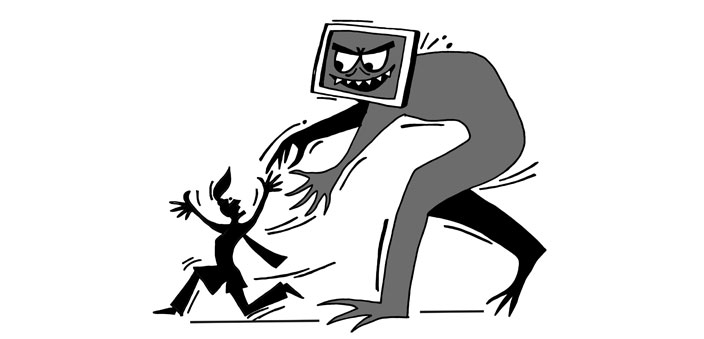Misogyny – described as hatred of or ingrained prejudice against women – finds ever new ways to express itself, it appears. The social media, the internet, the mobile phone – all powerful tools of communication, with the last mentioned even considered a safety aid for women are being used to stalk, harass and blackmail women and girls. Cyber stalking, cyber bullying, cyber pornography, using the mobile phone camera to blackmail or text offensive matter can have male victims too of course, but it is the women who bear the brunt of it. It is ironic and immensely distressing that technology that is considered to be empowering can actually be the source of physical, social and psychological trauma for women.
India’s dubious new revolution
India’s phenomenal attraction for the mobile phone and internet is a talking point, and in terms of the sheer number of users of both, we are apparently poised to overtake almost all other countries shortly. It is no surprise then that cyber crimes and blackmail and harassment via the mobile phone is also on the rise. In the period 2010 to 2013 alone, according to the Business Standard quoting the National Crime Records Bureau, registered cases of cyber crime shot up by 350% from 966 to 4,356! Imagine how much that figure must have increased up to the present and how many must go unregistered. Of course, these figures include all forms of cyber crime, but a search on the internet shows that each state in the country is showing a rising incidence of such crimes against women.
That women make ‘soft’ and easy targets especially in India is a fairly obvious conclusion. All our socio-cultural prejudices go towards not only making the victim feel guilty, but also discouraging her from complaining. Almost every day newspapers report cases of girls being blackmailed and women who have sought divorce or refused a suitor or confronted a harasser, being defamed with their personal details being uploaded or being sent obscene suggestive texts. Read any article that talks of women’s issues and scroll down to the comments section. You will find any number of downright abusive, sexist and misogynistic trolls having a field day. Women journalists have also had the experience of being “targeted”, whether on facebook or twitter. The examples of all these kinds of crimes are simply too many and widely reported, to again be mentioned here.
How equipped are we to handle cyber crimes?
Interestingly, as lawyers and activists point out, our police and other authorities concerned are hardly well trained or well equipped even to handle such cases effectively enough to ensure conviction. The collection of electronic evidence is obviously a highly skilled task.
There has been criticism that after the Supreme Court scrapped Section 66 (A) of the Information Technology Act (it allowed arrest of persons posting offensive content on social media), there has been a rise in such crimes.
However, there are others who point out that a combination of the IT Act and the Indian Penal Code (IPC) sections can nail the culprit, provided the victim is ready to follow through and the police take the case seriously. Legal experts say that Sections 354 D and 292 of the IPC, Sections 43, 66, 66C, 67 and 67A cover a large gamut of such crimes including stalking, trolling and harassment. They also advise victims to keep and maintain an electronic trail of the harassment instead of simply deleting it and hoping that the culprit will disappear.
Ultimately, all these issues boil down to one prime factor: how seriously does the society and all others involved treat the safety of women? Post the 16 December 2012 gang rape case, there is a heightened sense of awareness in the media and in public discourse about women’s safety. But it is a moot point if the authorities and especially the police are giving this issue the importance it deserves in terms of sensitisation and water tight investigation.
But it is not enough to point a finger at the law and order machinery alone. News reports say that there are proposals to set up the National Cyber Crime Coordination Centre which will look into all aspects of cyber security and crime at all levels, from the individual to the national. However, until that happens, it is the other stake holders – parents, teachers, significant elders – who must also ensure that the girl child is taught to take on her tormentors. That she is not conditioned to believe that she is the one who should feel ashamed and keep silent hoping that her tormentor will stop of his own accord. Experience shows that that rarely, if ever, happens. The culprit fuelled by the anonymity offered by the ‘net’ feels even more emboldened to pursue the victim. In such cases, inaction and ignoring the perpetrator can cost lives. In the western countries, there are many cases of teenagers committing suicide because they are unable to bear the jeering and online bullying.
It is here that the parents’ role is the most important – not just in helping the victim to fight back, but also to make their children and youth aware of the power of the ‘net’ and the social media.


 [/column]
[/column]